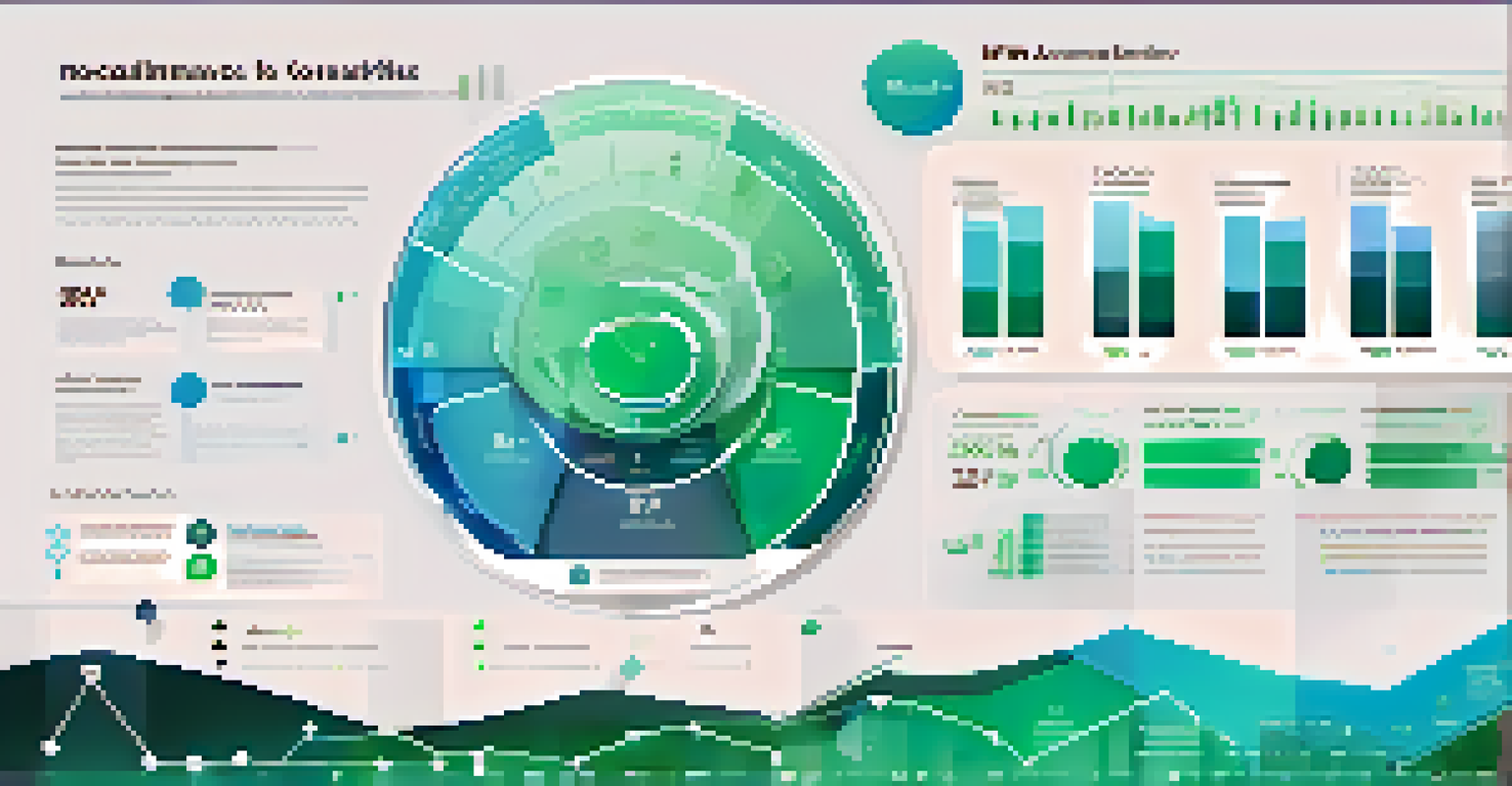Augmented Analytics: Best Practices for Implementation

Understanding Augmented Analytics and Its Benefits
Augmented analytics leverages artificial intelligence (AI) to enhance data analytics processes. By automating data preparation and insight generation, it empowers users to make data-driven decisions more efficiently. This means that even those without a strong analytical background can gain valuable insights, transforming how businesses operate.
Data is the new oil. It's valuable, but if unrefined it cannot really be used.
For instance, imagine a small business owner who previously relied on intuition. With augmented analytics, they can quickly visualize sales trends and customer preferences, making informed decisions that drive growth. This technology not only increases efficiency but also democratizes data access across the organization.
Overall, understanding the benefits of augmented analytics is crucial for organizations looking to stay competitive. By embracing this technology, businesses can uncover insights that might have otherwise gone unnoticed, leading to better strategies and improved outcomes.
Assessing Your Organization’s Readiness for Implementation
Before diving into augmented analytics, it's essential to assess whether your organization is ready for this transformation. Start by evaluating your current data infrastructure, including the quality and accessibility of your data. This step ensures that your existing systems can support the advanced analytics tools you plan to implement.

Additionally, consider the skill levels of your team members. Are they comfortable with data analysis, or would they require training? Understanding your team's capabilities will help you tailor your implementation strategy, ensuring that everyone can effectively use the new tools to their advantage.
Augmented Analytics Transforms Decisions
Augmented analytics enhances data analysis by automating processes and enabling users to gain insights without needing a strong analytical background.
Ultimately, readiness assessment sets the foundation for a successful implementation of augmented analytics. It allows you to identify potential gaps and areas for improvement, enabling a smoother transition and maximizing the technology's benefits.
Choosing the Right Augmented Analytics Tools
Selecting the right tools is crucial for maximizing the benefits of augmented analytics. With a plethora of options available, it's essential to align your choice with your organization's specific needs and goals. Look for tools that offer user-friendly interfaces, advanced AI capabilities, and seamless integration with your existing systems.
Without data, you're just another person with an opinion.
For example, if your team primarily consists of non-technical users, a tool with intuitive drag-and-drop features might be the best fit. On the other hand, if you need advanced predictive analytics, consider tools that emphasize machine learning capabilities. The right tool will empower your team to explore data confidently and derive actionable insights.
Remember, the effectiveness of your augmented analytics strategy hinges on the tools you choose. Take the time to evaluate your options critically, and don't hesitate to seek demonstrations or trials to find the best match for your organization.
Integrating Augmented Analytics into Existing Workflows
Once you've selected the right tools, the next step is integrating augmented analytics into your organization's existing workflows. This integration is vital for ensuring that the insights generated can be easily applied to day-to-day operations. Start by identifying key processes where augmented analytics can add value, such as marketing campaigns or inventory management.
Moreover, involve your team in this integration process. By understanding how they currently work, you can identify areas where augmented analytics can streamline tasks or improve decision-making. Encourage feedback and collaboration to create a smoother transition.
Assess Readiness for Implementation
Evaluating your organization's data infrastructure and team capabilities is essential before implementing augmented analytics to ensure a successful transition.
Ultimately, a successful integration will not only enhance productivity but also foster a culture of data-driven decision-making. When employees see the tools working seamlessly with their daily tasks, they are more likely to embrace and utilize augmented analytics.
Training Your Team for Effective Use of Analytics
Training is a critical component of implementing augmented analytics successfully. Even the best tools can fall flat if users don't know how to leverage them effectively. Consider developing a comprehensive training program that covers the basics of data analysis as well as the specific features of the tools you've chosen.
For example, hands-on workshops can help users become more comfortable with the technology while fostering collaboration. Additionally, providing ongoing support and resources, such as user manuals or online tutorials, can reinforce learning and build confidence among team members.
Investing in your team's training not only enhances their skills but also empowers them to take full advantage of augmented analytics. This, in turn, leads to better insights and more informed decisions across the organization.
Establishing a Data Governance Framework
Data governance is essential for ensuring that your augmented analytics implementation is effective and trustworthy. Establishing a framework helps manage data quality, security, and compliance, which are crucial for accurate analysis. Start by defining roles and responsibilities within your organization to oversee data governance initiatives.
Moreover, ensure that your governance policies address data privacy concerns, particularly with regulations like GDPR. This not only protects your organization from legal issues but also builds trust with customers, who value transparency regarding their data.
Foster a Data-Driven Culture
Encouraging a culture of data-driven decision-making within your organization empowers all employees to leverage insights effectively for better outcomes.
Ultimately, a robust data governance framework provides the necessary foundation for successful augmented analytics. It ensures that the insights generated are based on high-quality data, leading to more reliable decision-making.
Measuring Success: Key Performance Indicators (KPIs)
To assess the effectiveness of your augmented analytics implementation, establish key performance indicators (KPIs) that align with your business objectives. These metrics will help you track progress and identify areas for improvement. Examples of KPIs could include the speed of data analysis, the number of insights generated, or the impact on decision-making.
Regularly review these KPIs to gauge the success of your implementation. This ongoing evaluation allows you to make data-driven adjustments to your strategy, ensuring that you’re maximizing the benefits of augmented analytics as your organization evolves.

Ultimately, measuring success with KPIs creates a feedback loop that fosters continuous improvement. By staying attuned to your analytics performance, you can adapt your approach and drive lasting positive change within your organization.
Fostering a Culture of Data-Driven Decision Making
The final piece of the puzzle is fostering a culture of data-driven decision-making within your organization. Encourage all employees, from top executives to entry-level staff, to embrace data as a key component of their decision-making processes. This cultural shift can significantly enhance the effectiveness of your augmented analytics implementation.
To promote this culture, share success stories and highlight how data-driven decisions have positively impacted the organization. Consider establishing cross-departmental teams that focus on analyzing data collaboratively, reinforcing the idea that everyone plays a role in leveraging insights.
By embedding a data-driven mindset into your organizational culture, you not only maximize the benefits of augmented analytics but also empower your team to innovate and adapt in an increasingly competitive landscape.